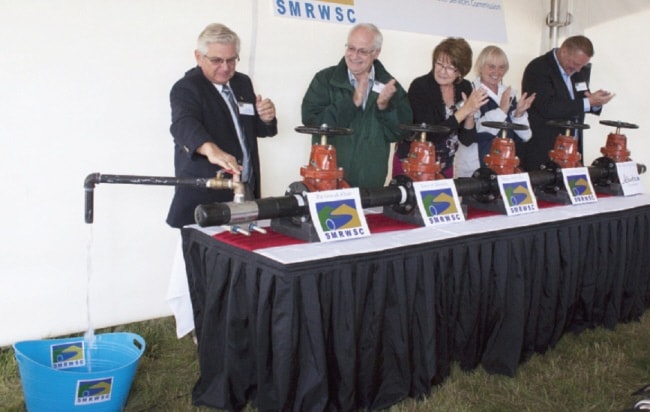When residents of Big Valley used to turn the tap, the product that wetly sputtered from the tap wasn’t always drinkable.
In fact, sometimes it was flammable.
Anecdotal accounts about teachers dousing burning napkins in water only to have them roar into towering flames, globs of black gooey oil coming from the tap, and having to let water stand so the fumes would dissipate were only some of the tales shared in Stettler County on Wednesday, Aug. 20.
The venue was the Shirley McClellan Regional Water Services Commission water transfer site, where dignitaries from the province of Alberta, the County of Stettler, Town of Stettler, and villages of Big Valley and Donalda joined members of the commission for a ceremonial turning of the taps to mark the completion of the second and third stages of its water delivery Master Plan, which would see clean, potable water delivered to communities all through Stettler County and parts of the neighbouring counties of Lacombe and Camrose.
Sixteen communities in all belong to the commission, which five years ago completed the first stage of the plan, building 142 km of water pipeline, bringing water from Stettler all the way to Consort.
“Water is the key to life, especially in areas where agriculture is a primary industry,” Wayne Drysdale, minister of Transportation for the province, said during the ceremony. “Coming from a rural area I fully understand how critical water supply is to keeping our communities and agriculture and industry vibrant.”
The province has paid 90 per cent of the master plan costs to date, with the project coming in at a hefty $64 million to date.
The first stage cost $50 million, and the second stage bringing water to Big Valley and Donalda came in at roughly $14 million.
“We all share the responsibility to ensure a healthy, secure and sustainable water supply for our communities, environment, and economy,” Drysdale said. “Our quality of life depends on it.”
To date, 91 Water for Life projects in Alberta have been completed, with another 62 currently underway. The 153 projects have cost roughly $820 million on the water infrastructure projects in the past seven years.
“We were known for having flammable water,” Big Valley Deputy Mayor Lois Miller said. “I don’t know what our firefighters did. We drilled wells, but in 2003, we ran out of water.”
Several years of drought conditions left the valley’s wells dry, and although they recovered, the village – which has been growing – has lived with the fear of dry wells ever since.
“(It is) a great fear,” Miller said. “How can our village expand?”
With the turning of the tap, clean and fresh water has flowed into Miller’s community, and she admitted to everyone that she was one of the first ones to toss her filter system aside and drink straight from the tap.
“With Shirley McClellan we have a chance of prosperity,” she said. “We have a chance to grow.”
The sentiment was shared by Donalda mayor Bruce Gartside.
“Our water was turned on last week so we’ve not had a chance to really see an impact,” he said. “But this will increase opportunities in our community.”
There were laughs when Gartside thanked organizers for promoting the villages of Big Valley and Donalda to towns, but he noted that with fresh and drinkable water available to the communities, the chance for growth is there, and maybe someday they’ll live up to the accidental promotion in status.
It hasn’t always been an easy ride for the commission, which was spearheaded by the titular Shirley McClellan. Her name has become synonymous with fresh water in the communities served by the water pipelines, and by the communities that have signed on and are waiting for the master plan phases that will connect their communities.
Representatives from all 16 member communities were there, and McClellan herself thanked them all for supporting the other communities who were now getting water – and for supporting them while waiting for their projects to begin.
“It’s been a long road,” she said. “And some of those meetings – oh, those meetings.”
Resistance from the member communities was fierce at first as councils struggled with the concept of giving up control of their water utilities and treatment facilities. In the end, however, centralization allowed for financial savings, which in turn is invested back into the equipment that keeps water systems going.
“I do appreciate Shirley’s pioneering spirit,” Gartside said.
Town of Stettler’s Malcolm Fisher likened the commission’s persistent membership to the pioneers who came out to western Canada with no guarantees, no trails, and no surety.
“They needed courage, persistence and tenacity, and we have that in the commission,” he said.
With the completion of this phase of the master plan, all communities in the County of Stettler excepting Buffalo Lake south shore have been connected to the water line, and the infrastructure is there for individual farms to hook up. A reservoir and water transfer site are nearing completion just west of the town as well.
